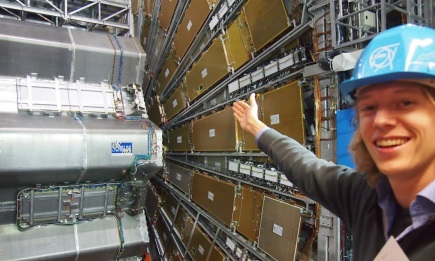The battle of the Linear Colliders

“The infrastructure that has been created by CERN, both physical and human, would make it easier to build the ‘next collider’ in Europe,” says Roger Ruber, a CLIC scientist to Sander Breur who visited CERN. When the collider will be built in Europe it would be the Compact Linear Collider (CLIC), a high-energy collider carried out by a world-wide collaboration of 43 institutes from 22 countries.
CLIC aims at accelerating and colliding electrons and positrons at an energy scale never reached by any existing collider. CLIC is in competition with the International Linear Collider (ILC) project, which seems to be both politically and technologically more feasible, but with a collision energy that is six times lower.
Hungry for a world-class research facility
Where CLIC would be a world-wide collaboration, the ILC will most likely be hosted and financed by Japan. Due to the financial crisis, Japan is the only country willing and able to pay the needed $8 billion – or the $25 billion according to Steven Chu – for the ILC.
Ever since Japan lost the bid of the prototype fusion reaction ITER to France, it is has been hungry for a topnotch research facility. The devastating earthquake and tsunami of March 2011, led to enormous reconstructions funds, of which also scientific projects, like the ILC, are funded.
The future of physics
“CLIC won’t only determine the future of CERN, but also for particle colliders, and maybe even the entire future of physics,” says Ruber. “The question whether to choose for CLIC is not just physics or technology, but is to a large extent economic and political.”
“If you want to build a collider today, there are two options. The first option is a proton collider like the Large Hadron Collider, when you want to do experiments that need more energy you’ll need to build a bigger ring. The other realistic alternative at this time is a linear collider,” says Ruber. To turn CLIC from a research project into a full fletched industrialized collider, would take years or potentially decades.
Great scientific questions could be answered by the research that CLIC would be able to facilitate. “New steps and more accurate measurements in the research on Higgs-bosons or dark matter can be made in CLIC. It wouldn’t just be a ‘Higgs-factory,” Ruber says.
Don’t fight, cooperate
Barry Barish, the director of the ILC project explains why he sees the ILC as the more realistic alternative: “It is clear that the timescale for a machine like CLIC, even if feasible, is much later than the ILC. So the reason to consider CLIC is for energy reach, if required.”
As early as 2007 Barish pleads for more collaboration between the two projects: “For some time now, I have been coming to view that the ILC and CLIC efforts should be more closely integrated. Beyond the feasibility tests for CLIC, their emerging work will involve physics studies, detector concepts and a first-order design of the rest of the accelerator complex.”
“For this work, CLIC faces many of the same issues we are dealing with for the ILC, with some significant differences due to the different technology and energy. Nevertheless, to best accomplish the work for both projects and to be best able to evaluate alternative approaches to the lepton collider, like a warm machine or CLIC, we should do all we can to integrate these R&D and design efforts,” Barish says.
Enabling cancer treatments
“When there will be invested in particle science there will be unexpected benefits for society,” Ruber explains. “The internet wasn’t designed to watch videos on YouTube, but now huge masses use it that way. People have been working for decades on linear collider technology and now it’s used by DESY in Hamburg to build the next generation of X-ray lasers.”
This X-ray technology is used by medical researchers to treat cancer. With this technology only the tumors receive radiation, which is less harmful for the patient. With the technology that might spin off CLIC, the size and price of these machines can be heavily reduced. “It is very stimulating that there are all these inspiring spin offs of our technology,” says Ruber.
Meest Gelezen
Vrouwen houden universiteit draaiende, maar krijgen daarvoor geen waardering
Wederom intimidatie van journalisten door universiteit, nu in Delft
‘Burgerschapsonderwijs moet ook verplicht worden in hbo en wo’
Raad van State: laat taaltoets nog niet gelden voor hbo-opleidingen
Hbo-docent wil wel rolmodel zijn, maar niet eigen moreel kompas opdringen

